How to spot a spinning black hole: Twisted space-time should be visible from Earth, say researchers

(PhysOrg.com) -- An international group of astronomers and physicists – including Dr Gabriel Molina-Terriza of Macquarie University Sydney has found that rotating black holes leave an imprint on passing radiation that ought to be detectable using today’s most sensitive radio telescopes. Observing this signature, they say, could tell us more about how galaxies evolve and provide a further test of Einstein’s general theory of relativity.
General relativity tells us that very massive objects such as black holes warp space-time such that the path of any passing light is bent, an effect known as gravitational lensing. The theory also predicts that when a black hole rotates it will drag space-time around with it, creating a vortex that constrains all nearby objects, including photons, to follow that rotation.
Astronomers already have evidence that the supermassive black holes believed to lie at the core of many galaxies rotate. However, this evidence is indirect. The rotation of the Milky Way’s black hole, for example, is suggested by the velocity distribution of stars within the galaxy, but this approach is undermined because we don’t know exactly how much matter, particularly dark matter, the galaxy contains. Some astronomers believe that the Milky Way’s black hole is rotating very quickly while others maintain it is rotating much more slowly.
In the latest work, Fabrizio Tamburini of the University of Padova in Italy and colleagues instead show how to detect the rotation by measuring changes to the light from a distant star or from the disk of accreted material surrounding a black hole. They point out that a wavefront travelling in a plane perpendicular to the black hole’s axis of spin will get twisted as it passes close to the black hole, since half of the wave front will be moving in the direction of advancing space-time and the other half in the direction of receding space-time. In other words, the phase of the radiation emanating from close to a rotating black hole should have a distinctive distribution in space.
The researchers used a computer simulation to model the phase distribution resulting from the rotation of the Milky Way’s black hole and found that this variation ought to be visible from the ground. They say the way to measure it is to point an array of radio telescopes at the centre of the galaxy, using different telescopes to observe different segments of the approaching wave front, and then superimpose these segments to calculate their relative phase. This procedure would be repeated, each time the telescopes pointing to a different section of the tiny patch of sky surrounding the black hole.
Tamburini describes his group’s findings as “fundamentally important”, given, he says, that most massive objects in the universe rotate. In particular, he believes that studying the rotation of black holes in active galactic nuclei can provide a lot of information about the evolution of these galaxies. And he maintains that his group could carry out such measurements within two years using an existing array of radio telescopes, such as the Very Long Baseline Array in the US, or the LOIS-LOFAR in Europe, were funding forthcoming.
Provided by Macquarie University













.jpg)




